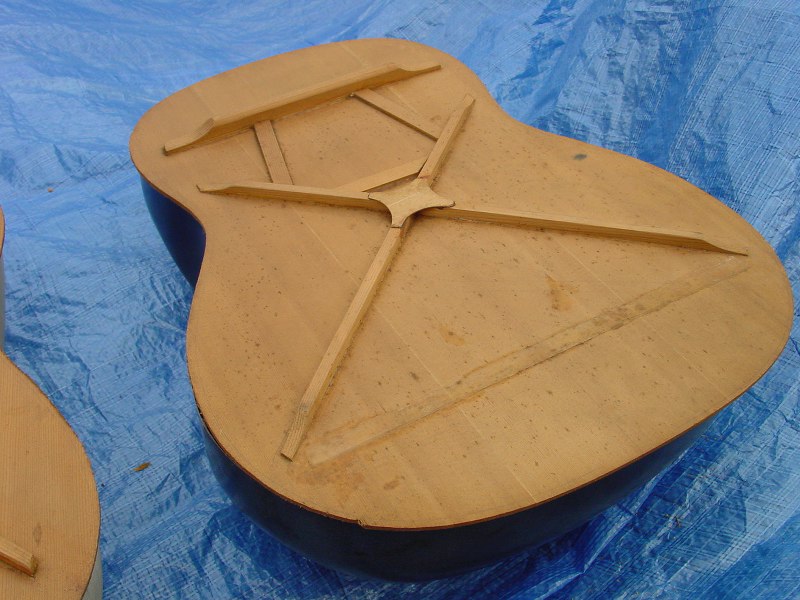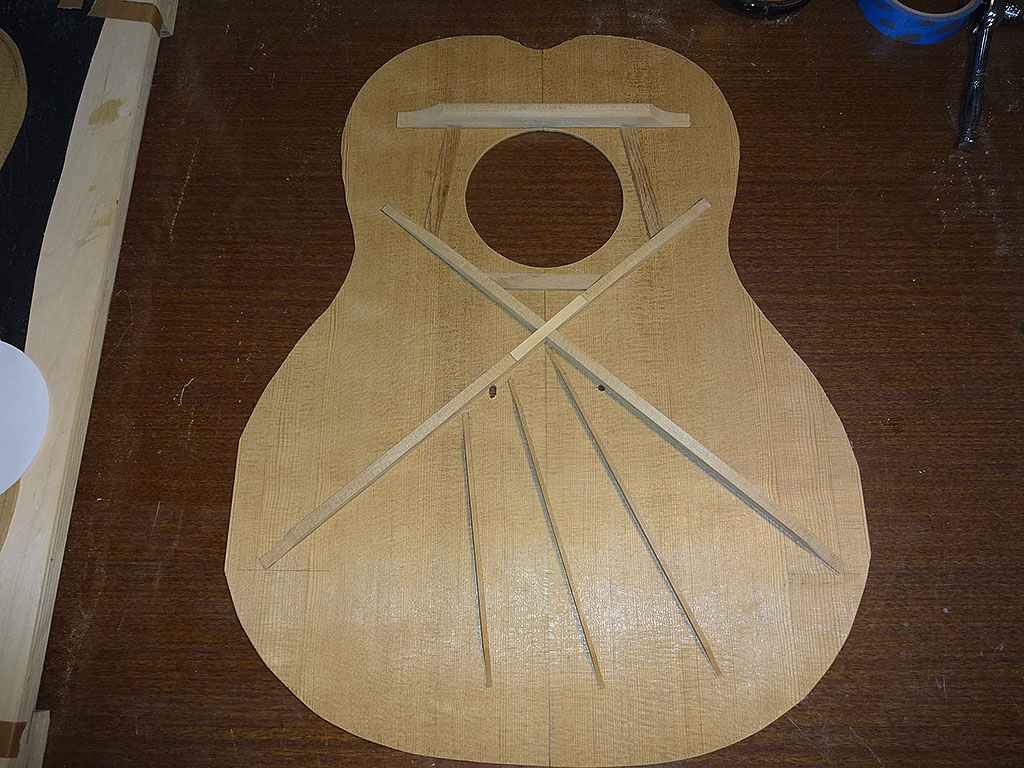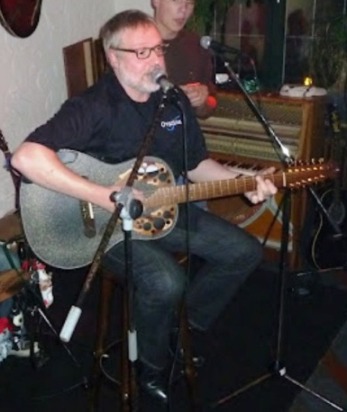|
|
Joined:
May 2011
Posts: 82
Location: Ozark, Arkansa | Dan Savage, I saw a post on the OCB page, in which you remarked that you think the Classic is over-braced. That is no doubt true for later models, but my 67 is astonishingly barren of braces.
From what I can see with a light and mirror, there is an X brace with an extremely thin horizontal strip that runs laterally between the lower legs, about halfway between the bridge and binding. There isn't even any bridge plate underneath. Have you ever seen a bracing pattern for these early models?
The reason I am inquiring, is that at a certain frequency, specifically the E note on the D string, I hear a bit of a buzz. Slight, but unless my ears deceive me, it is there. At first I thought it must be a brace popped loose on one end, but like I said, there is hardly any bracing.
When I was initially examining the guitar, pre-purchase, I was tapping on the top, and when I got to the lower bass area I thought I heard something, but couldn't be sure.
I really don't want to replace the top for so minor a defect, but I know it will always annoy me.
Suggestions? | |
| | |
Joined:
November 2002
Posts: 3651
Location: Pacific Northwest Inland Empire | 1st idea: See if you can get a .010 feeler gauge under the braces, somewhere. | |
| | |

Joined:
June 2012
Posts: 2339
Location: Pueblo West, CO | Steve,
You didn't note what the thin strip between the X-braces was made of. I'm pretty surprised to read that the 1967 Classic had X-braces. I checked the 1960s brochures on Jerome's site. The 1967 Classic brochure only mentions 'Top bracing is scientifically desined to encourage the sympathetic resonances...' None of the other brochure/catalogs through 1970 make any mention of bracing. Bridge plates are only necessary for pinned bridges to prevent the ball ends of the strings from pulling through the spruce top.
The original X-braces were very simple affairs with no scallops, no tone bars and no finger braces.
The only lateral bracing was a 1/2" wide fiberglass strip that ran between the lower legs of the X-braces. 
The Modifed X-braces were mostly the same as the original braces, but the fiberglass strip was dropped in favor of three tone bars between the lower legs of the X-braces. The 1/16" birch ply X-shaped center glue joint was changed to a simple strip of 1/16" birch ply.

As seesquare suggests, you could use a feeler gauge to check it. Or, a flashlight.
Edited by DanSavage 2020-07-03 1:54 PM
| |
| | |
Joined:
May 2011
Posts: 82
Location: Ozark, Arkansa | The top image is exactly what I have for bracing. My best guess at this point is that the bass side leg is popped loose. Thanks. | |
| | |

Joined:
June 2012
Posts: 2339
Location: Pueblo West, CO | Good luck! | |
| | |
Joined:
May 2011
Posts: 82
Location: Ozark, Arkansa | Aggggggh! I have figured out where the buzz is.
I pulled the strings, and videoed the inside with my iPhone. Could not find anything that appeared loose. Did discover that the strip that transverses the top is wood, perhaps birch. Also discovered there is no kerfing. It is a lip which to me seems a precursor to the suspension ring that Adamas guitars use.
I wondered, is it possible that it is not epoxied at some point on the ring, but the video showed a lip of epoxy all around the ring.
So I started tapping again, and then I heard it...in the neck. Could it be, the truss rod vibrating in the neck? I pulled the TRC, and sure enough, the nut was not tight. Eureka, I thought. I tightened the nut and tapped again, only to still hear the buzz in the neck. And no amount of tightening would stop it.
So, I am regrouping to figure out what to try next. But I am 99.99% positive, this is the source of my buzz.
Ideas? | |
| | |
Joined:
November 2002
Posts: 3651
Location: Pacific Northwest Inland Empire | This is pretty radical, but you asked.................. Pull the fretwire at the neck joint, drill a small hole, & inject a bit of glue. Just might work! Remember, this IS the bottomfeeder's venue. Some folks raised the bar, pretty early in the evolution. | |
| | |

Joined:
June 2012
Posts: 2339
Location: Pueblo West, CO | Did the TR nut tighten up enough to alter the relief?
I'm asking about whether the TR feels like it's broken. | |
| | |
Joined:
May 2011
Posts: 82
Location: Ozark, Arkansa | Dan, I knew I should have answered that question before it was asked. The nut tightens, ie., eventually stops turning, but I am not sure it is altering the neck relief. The neck is so massive, I am not sure how much tension I can put on it to change it. But it does not feel broken. I thought of that too.
Seesquare, I thought the same thing, but was really thinking more toward the center of the neck. I was thinking about the possibility of injecting some expanding foam glue (poly) so there is a greater chance of stopping the vibration.
BUT, before I get too far downstream, I did discover part of the buzz was from all the loose tuning machine parts without string tension on them. Part, but not all. So I am thinking I may have to put at least the D string on and bring it up to tension, now that I have tightened the truss rod nut and see if the original problem was addressed. I wish I had checked the rod nut before I unstrung it. Oh, well.
Edited by Oldvation Guy 2020-07-07 7:25 PM
| |
| | |

Joined:
June 2012
Posts: 2339
Location: Pueblo West, CO | Even if the strings aren't on, you should still be able to see the TR alter the relief.
To check relief, sight down the neck from the nut to the bridge.
If the nut is bottomed out on the threads, you should be able to see a visible back bow, even without strings.
Edited by DanSavage 2020-07-07 7:50 PM
| |
| | |

Joined:
May 2011
Posts: 760
Location: Muenster/Germany | 99 % of all strange buzzes I had on or in guitars came not from where I thought them to be. And at least 90 % came from loose parts of tuning machines or other hardware. | |
| |
|
 1967 1113 Classic Bracing
1967 1113 Classic Bracing 1967 1113 Classic Bracing
1967 1113 Classic Bracing